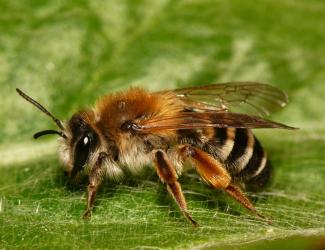
Image Credit: Dick Belgers
Spring Bees (Andrenidae: Andrena)
This is the most diverse group of bees in the Pacific Northwest, with at least 150 species that vary greatly in size and coloration. Two species in this group are “large” (including the very common Andrena prunorum, which prefers orchard trees but is a generalist), and the rest are smaller, 2/8-3/8 inches long. Nearly all the species are early spring flyers, often emerging very early in the spring, you may frequently encounter them sunning themselves on the bare ground or small rocks; they require body temperatures the same as birds in order to fly efficiently. Exceptions include one subgenus that frequents sunflowers in mid-summer, and another very hairy subgenus frequents late summer aster family flowers such as goldenrod.
About half of the species are likely to be specialist-feeders on only 1 genus of plants (or several closely related ones). For example, the specialist-feeders are the subgenus Onagandrena in the southwestern deserts specialize on dawn- or evening-blooming primrose (Camissonia) flowers; they are especially large, dark colored (melanic) and adapted to low visibility conditions. About half of all the Andrena species have males with bright yellow facial markings. The physical characteristic which separates Andrena from all other bees is the presence of 2 linear ridges stretching from the base of each antenna to the upper lip (“clypeus”); all other bees only have a single ridge from each antenna. (But, it is very hard to see the ridges due to the dense hair on the face.)
They are ground nesters and sometimes called “mining bees”. It is often possible to see hundreds of independent nests on the bare earth under/near a backyard fruit tree in bloom. Some of the earliest species are known to collect pollen for the young from the normally wind-pollinated maple trees.


Andrena bees are about half the time with fasciae (transverse apical abdominal bands of hair) and half without. The fascia on nearly all Andrena are rather narrow and they tend to wear off with age and activity.


Some Andrena species are partly or wholly red on the abdomen. Some Andrena species are entirely melanic.


Several species of PNW Andrena have violet-blue iridescence on the bodies. Probably about half of the PNW Andrena have yellow upper-lips (“clypeus”) in the males, but the other half do not. The females never have yellow on the face.

An interesting note about the Andrena genus is that they account for most of the recorded instances of orchid pollination by male bees that actually try to inseminate the flowers because they mimic the perfumes of the female bees. Notice the stamen of the orchid that is attached to the abdomen of the bee!